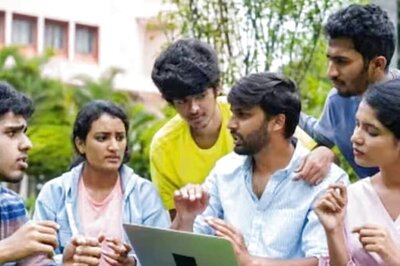
views
The Fraunhofer Institute has been a long-time trusted innovation partner in India, collaborating with some of the major players in the field of material science, energy, environment, automotive, electro-mobility, production technology, microsystems and smart cities, working with industry, government and public sector. The Fraunhofer-Gesellschaft based in Germany is the world’s leading applied research organisation, prioritising key future-relevant technologies and commercialising its findings in business and industry.
Fraunhofer is the technology partner to the Government of India in manufacturing and also partners with the Ministry of New and Renewable Energy and the Department of Science and Technology. It also works in tandem with the NITI Aayog and with the PM’s Scientific Advisory Council.
In an exclusive interview to News18, Fraunhofer Institute’s India Office director Anandi Iyer talked about India’s position in global research and innovation, and lauded Prime Minister Narendra Modi’s push for women-led development during India’s presidency of the G20.
Edited excerpts
The recently passed Anusandhan National Research Foundation (NRF) Bill, 2023 is poised to provide high-level strategic direction for research, innovation, and entrepreneurship in natural sciences. How does Fraunhofer see this bill?
It is really exciting to see the Indian government draw out such a path-breaking bill because, for the past many years, India’s contribution in terms of GDP to R&D has stayed at 0.7-0.8%, whereas the global average of GDP of other countries (to R&D) is about 1.8%. Israel’s GDP to R&D is well above 4% and even China’s stands at 2.1%. The government has consistently maintained that we should be moving towards 2% with 2025 as one of the target years.
The government’s production-linked incentive initiative is excellent and is directed towards increasing research by the industry and other stakeholders. With this move, we hope that the framework of research partnership will be more robust and backed by the government so that various stakeholders are incentivised to collaborate.
In Germany, where Fraunhofer was one of the key pillars of this innovation ecosystem, the strength comes from the seamless cooperation between universities, research organisations and applied research organisations like Fraunhofer and then the industry.
The lack of low number of research papers or publications that come out of India should also be tackled. It’s only about 45,000 compared to around a million from the US. And China is putting in 1.53 million patent applications.
I think the NRF Bill 2023 primarily looks at resolving declining research investments and how to upgrade it, and how to improve the collaborative framework of innovation. I think it is an extremely important bill that has come at the right time.
Fraunhofer is a pioneer in applied research across the world. India is on the cusp of becoming one of the top three world economies in the next five years. How do you perceive India’s growth and future perspective when it comes to research and innovation, especially through partnerships with academia, researchers, and the Government of India?
Fraunhofer has been present in India for the last 15 years and we work with a wide network of stakeholders like the government, the academia, research organisations like the CSIR and the industry, who are our primary and first-level clients. We take research from the labs to the markets in the shortest period of time. With over 35,000 employees and an annual research budget of 3 billion euros, we are one of the largest patent producers and innovation ecosystems globally.
While India is extremely entrepreneurial and very market savvy, it looks at the R&D, particularly proprietary R&D, as a cost rather than an investment. So when you say the Prime Minister talked about manufacturing and aimed to take it from 16% to 25% of the GDP, it’s a leapfrogging move, yet it cannot happen when you look at R&D as just greening of patents or licensing.
We have to look at large investments towards R&D that considers at least a three to five-year scenario to develop capabilities in R&D. We must look at process innovation, not just incremental innovation. If we can encourage Indian industry to look more into R&D as an investment, not in the immediate term but rather a medium-term investment, it will catapult India into the league of nations where you are led by innovation.
Are we heading in the right direction with respect to creation of R&D ecosystem in India?
We are taking baby steps in the right direction. I see a lot of appetite incidentally around the medium-level companies, young entrepreneurs, second-generation entrepreneurs who are now changing track from the old business and trying to bring in new elements. For example, JBM is an automotive component supplier and today they are leading an EV (electric vehicle) segment. These are changes that the next generation is bringing in which is outstanding to see. The more time we take to make this paradigm shift, the more heavily it is going to cost us.
Your expertise is in the circular economy and business development management fields. How do you see the circular economy becoming a trend in India and the country benefitting from the same?
This is really a double-edged sword. On the one hand, sustainability has been flagged off everywhere and there are a lot more reports today about ESG that you are aligning with social, environmental and corporate goals. But on the other hand, we hear that companies are not really submitting sustainability reports and still continue to do business as usual.
Fraunhofer thinks that if the industry sees value in these technologies that reduce costs, bring in more efficiencies, also impact the environment positively, then the adoption of these technologies will be faster. We are working together with the industries to understand their need and develop interventions that work for them, rather than see it as a prescriptive model, which they may feel forced to pick up.
Fraunhofer is also organising the Fraunhofer Innovation and Technology Summit in Bangalore. What could be the most interesting takeaways for the Indian scientific community, especially those in research and innovation?
At the Fraunhofer Innovation & Technology (FIT) platform, we will have over 20 experts across manufacturing, mobility, energy, water nexus, as well as packaging. We will be showcasing these interventions that can be interesting, profitable for the industry and make a lot of economic sense, not just, social and environmental sense.
Fraunhofer is the technology partner to the Government of India in manufacturing. We are the partner with the Ministry of New and Renewable Energy and are partnering on hydrogen technologies with the Department of Science and Technology. We also work in tandem with the NITI Aayog and with the PM’s Scientific Advisory Council. Fraunhofer is well-entrenched with this ecosystem.
We hope to sign a couple of really exciting MoUs during the FIT in Bengaluru. Our MoU is not just a memorandum of understanding, it’s actually a project that we are implementing. As a not-for-profit organisation, it is very aware of its important role in the society to contribute to a better society. We have a vital role to play in India.
One of the biggest contributions that we can make to India today is to help develop the innovation ecosystem like we have done in Germany, Brazil, Dubai, China where this acceleration of research to market from the labs becomes a reality in a shorter of period of time than what is happening today. It is already happening in India where Fraunhofer has worked with over seven partners to develop light weighting projects for the automotive industry where companies like Ashok Leyland, TATA, A.R.C.I. (Hyderabad) were involved along with the Government of India.
Similarly, we have done training programs for BML Munjal University because we felt that one of the key elements in research are the students who stay back and do their PhD in India. We often talk about the demographic dividend in India. With them, we have co-developed a program called ‘Joy of Engineering’ to retain students in science and engineering rather than letting them go into softer areas or other areas like IT.
We have done a lot of work on solar energy which we are very proud of whether it is large area coating to bring down the costs and increase the efficiency for solar energy panels. Just a month ago, we showcased the sustainable neighbourhood in Kochi where we demonstrated through about 600 houses how we can create a small neighbourhood which is sustainable in water management, in energy consumption but also in sustainable buildings.
How do you see India’s presidency of G20 and how does it impact the world in terms of environment, science and technology, SDGs, research, and innovation?
I think it’s fantastic that India has this leadership of G20 this time because the way it has panned out over the last eight months, where we have looked at every aspect of life and also taken various delegations from the world over, particularly in the G20 countries, to various parts of India to showcase not only our competence but also our cultural heritage and our capabilities.
I also happen to be the chair of the G20 Empower, Women in Science Working group where we have brought out a communique in line with our honourable Prime Minister’s clarion call of ‘women-led development’. What PM Modi has done to acknowledge and amplify the contribution of women in science is commendable. This is one great achievement of India’s presidency in the G20.
The call for action is to say not to consider women as a diversity card but actually look at the impact of women in an inclusive society. It is exciting to see women getting the attention and dignity they deserve and including them into the economic growth and prosperity of the country. Under PM Modi’s leadership, women in science have actually been included into the mainstream.
We have also brought out a working document report on women in Science, Technology, Engineering and Mathematics (STEM). We have made some concrete suggestions around including women in the economic workforce.
And we have also talked of mobility for women researchers around the world so that they get to talk to each other, they get strength and solace from each other and get role models they look up to. We have initiated quite a few activities. We don’t intend to give them up when G20 concludes. In fact, this is the beginning and we hope to take them forward. The G20 presidency has definitely offered India and the world a platform where shared values of a common world really come together.

















Comments
0 comment